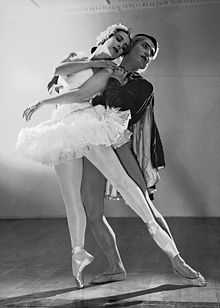Balanchine method
The Balanchine method is a style of ballet and associated ballet technique invented by dancer and choreographer George Balanchine. It is widely used throughout North America, though it is commonly associated with New York City Ballet and the School of American Ballet, where it first emerged and became popular.
Unlike some other ballet methods, such as Vaganova and Cecchetti, the Balanchine method is not taught by means of a standardized training system, nor is this term used as a common name for the various methods used to teach it.
Characteristics
The overall illusion of the Balanchine method is that dancers are utilizing more space in less time, so that speed, height, length and a syncopated musicality are created.[1]
Specific characteristics include:
- Extreme speed and very deep plié
- Emphasis on line, with use of unconventional, asymmetrical, abstract arm and hand placement
- Pirouettes en-dehors taken from a lunge in 4th, rather than the conventional plié in 4th
- Distinctive arabesque line with the hip open to the audience and the side arm pressed back
- Athletic dance quality
Background
In 1924 George Balanchine defected the Soviet Union and joined Diaghilev's Ballets Russes as a choreographer, becoming quite well known across Europe. His future partner and financier, Lincoln Kierstein, convinced him to come to the United States in 1934 following the death of Diaghilev, and together with Kierstein, Balanchine founded the School of American Ballet in New York.[2]
During his time in Europe, Balanchine developed his neoclassical style partially as a reaction to the Romantic anti-classicism which had led to increased theatricality in ballet. His style focused more on the dance, with the plot being secondary. In total, he choreographed 465 ballets, and it was this constant work that allowed him to refine his characteristic style. After coming to the United States, he became far and away the most prolific force in the nation's ballet community, which led to his long-enduring legacy.[3]
References
- ↑ Warren, Gretchen Ward. Classical Ballet Technique. University of South Florida Press, Gainesville, 1989.
- ↑ iSport Major Methods of Ballet
- ↑ NYC Ballet Bio
| ||||||||||||||||||||||||||||||||||||
